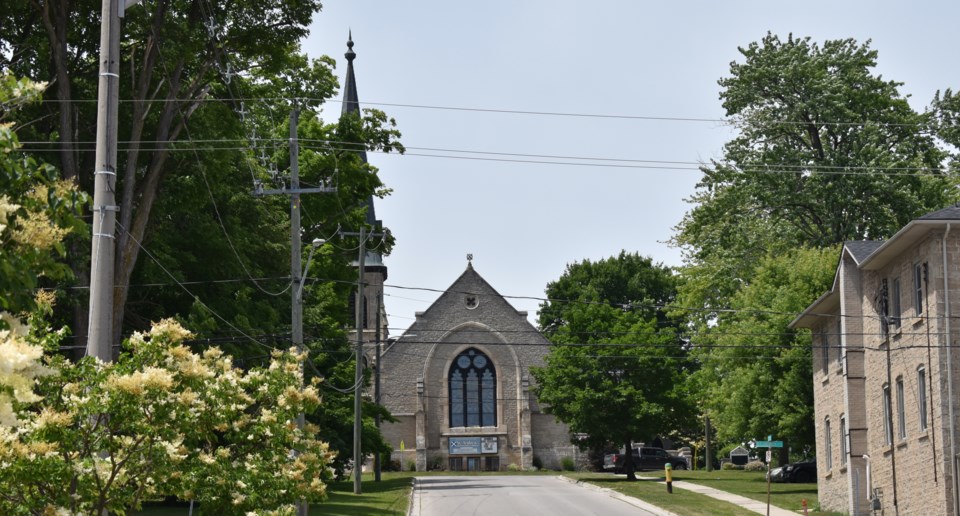There is a lot of Fergus history in St. Andrew’s Presbyterian Church. At one time it was not just the only church in Fergus, but also the only church between Guelph and Georgian Bay.
Adam Fergusson, one of the town’s founders, laid the cornerstone on Nov. 30, 1834, on a high point of land known as the Glebe – part of the Clergy Reserves, which was augmented by a grant of 171 acres from the colonial government of Canada. The original church, a frame building with a tin spire, was built by Charles Allan; a trustee, elder, county warden and member of parliament. The church opened its doors on Aug. 23, 1835.
Among the first ministers to speak from the pulpit in St. Andrew’s was Rev. Patrick Bell, who was visiting Fergus. He had gained fame as the inventor of a reaping machine. The first incumbent minister was Rev. Alexander Gardiner, who served from 1837 until his untimely death in 1842 at the age of 32. It was generally believed he had exhausted himself travelling around the countryside in all sorts of weather, administering to his widely-scattered parishioners. He was buried in St. Andrew’s churchyard, and his widow and young children returned to Scotland.
The first four ministers at St. Andrew’s came directly from Scotland. At that time there was a profound disruption in Presbyterian ranks between followers of the old and the new churches. The dispute spread to Canada. The recently-installed pastor at St. Andrew’s, Rev. George Smellie, several church elders and a large part of the congregation broke away from the church in 1847 to join the “Free Kirk” known as the Melville Church. A tablet commemorating the loyalty and determination of A. Dingwall Fordyce, the sole elder who remained with St. Andrew’s – and brother-in-law of James Webster, a town founder – was installed in the church.
By the mid-1850s the congregation had outgrown the frame church and the decision was made to construct a new one. Located on the site of the old church, it was constructed of limestone in the Gothic style. The new church opened on Dec. 28, 1862. In its tower was an 800-pound (362.8 kg) bell that was dedicated to the memory of Rev. Fergusson. The ladies of the church had raised a portion of the $417.72 needed to buy the bell.
The church began what would become a tradition of ringing the bell not only on Sundays, but also at noon and 6 p.m. every day.
The church’s basement was renovated to accommodate a Sunday school, and a new addition called the Fellowship Hall was constructed. That meant the church could further serve the community with more classrooms, a kitchen, a parlour and offices. A ceremonial key for opening the hall was kept on display in a cabinet along with a silver tray that is a memento to R.D. Kerry, superintendent of the Sunday school for over 30 years; and a tea service that was presented to Rev. J.B. Mullan on his retirement in 1907.
The aesthetic beauty of the sanctuary was enhanced with the addition of several stained glass windows and a carillon that was dedicated to the memory of six former ministers. A Celtic cross for the communion table was imported from Iona, Scotland. In 1917 the 153rd Wellington Rifles entrusted its flags and regimental colours to St. Andrew’s before departing for Europe and the Western Front.
The church’s other items of historic value include communion tokens and the original tuning fork that was used by the precentor (leader of the choir) before the installation of an organ in 1872.
As do so many of Ontario’s historical churches, St. Andrew’s has a cemetery that is something of a community chronicle. A burial ground was part of the original church site and was later enlarged and enclosed by a stone wall. David Smith, a dyker and mason from Scotland, and one of the town’s pioneer settlers, was commissioned to construct the wall. James McQueen was the first person to be put in charge of the burial ground, and he hired a former soldier named George Matthews as the first grave digger.
The graveyard had 147 plots which cost $4 each. As generations passed and the graveyard filled up, some of the plots were subdivided. The number of people buried there cannot be determined by the number of gravestones. Eventually, another cemetery – Belsyde – was opened.
The remains of many Fergus citizens were buried in St. Andrew’s churchyard between 1835 and 1950. One gravestone bears the name of Alexander Dyce Wilson, who actually drowned in Australia in 1859 and is buried there. One of the most curious headstone inscriptions is that of Robert McGillivray, who died in 1854 at the age of 41. According to the inscription, the date of McGillivray’s death was Feb. 30.



